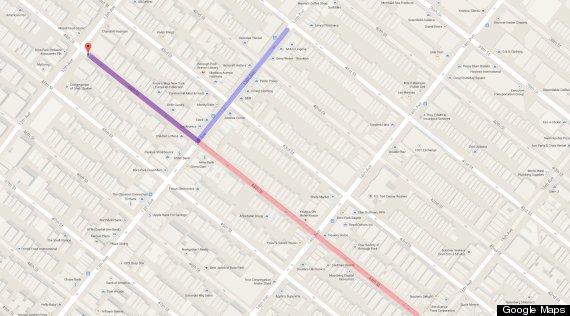They’re everywhere, and they’re watching you. They’re surveillance cameras, and following 9/11 they seemingly sprouted on every building, parking garage and traffic light. The exact number installed is difficult to assess, but oft-cited market research tracks sales at 30 million cameras. In New York City 6,000 public cameras gaze upon the city. In Chicago it’s 10,000 -- the densest concentration in the U.S.
While civil-liberties advocates summon the grim specter of George Orwell's 1984 (as cities roll out software that “automatically” recognizes suspicious behavior, we can’t exactly fault them), it’s hard to argue with the results. Crime dips as the cameras roll, research appears to show.
Together with Investigation Discovery’s “See No Evil,” airing Tuesdays at 10 p.m. (9 p.m. CST), we dug through the footage and found the baffling, blood-curdling, and just plain bizarre cases where being caught on camera led to being caught.
The Abduction Of Carlesha Freeland-Gaither
By the time surveillance cameras caught sight of an old Ford Taurus parking on a Philadelphia street, Carlesha Freeland-Gaither was already being hunted. As the camera rolls, a man hops out and skitters around the edge of the frame toward the distant figure of his victim, Freeland-Gaither, a 22-year-old nursing assistant. The predator lunges and manhandles her back toward his car and the camera. The desperate woman rocks the car -- even kicking out its windows -- with the force of her struggle.
Soon after the abduction, Philadelphia police released the video to the public. The dramatic footage garnered national media attention, but it also spurred the interest of a team of detectives far south of Philly. Police in Virginia were searching for a violent offender named Delvin Barnes, whose DNA had been found on a teenage girl who stumbled, naked and smelling of bleach, into a local gas station.

The case hinged on Barnes’ aging Ford Taurus
On a hunch, they showed the Philadelphia abduction video to Barnes’ father, who identified the Taurus as his son’s car. Detectives also spotted the decals of a local car dealership -- one that practiced a controversial technique of fitting GPS units on cars sold to customers with bad credit. When turned on, the GPS led police to a shopping center parking lot in Jessup, Maryland, where Barnes surrendered without a fight. Freeland-Gaither, injured but intact, was returned to her overjoyed family.
As they’re captured on camera sauntering down a Philadelphia street, this group seems to be having a good time. But on an October night in 2014, their members turned savagely violent. Around 10:45 p.m., the alleged attackers confronted the unfortunate victims, two gay men. Taunts about the men’s sexuality escalated quickly into open violence. Some members of the group pinned the men’s arms while other punched, kicked and robbed them.
The release of the details of the case and the accompanying video were met with public outrage, due to both the hideousness of the crime and the apparent privilege of the attackers. But then something interesting happened: social media sleuths began searching the video for clues. After a picture surfaced showing a similarly dressed group at Philly restaurant La Viola, Twitter user FanSince09 tracked down members of the group by referencing who had checked in at the restaurant on Facebook. (Criminal masterminds they were not.)
Three members of the group, which included the daughter of a county police chief, were indicted on charges of assault and conspiracy. For his work, FanSince09 received shoutouts from the police.
When news circulated in 2011 that Brooklyn 8-year-old Leiby Kletzky had not returned home from day camp, neighborhood do-gooder, Yaakov German, scrambled to help in the search. According to detailed reporting in New York Magazine, German obtained a surveillance video from his son, who was a teacher at the camp, that showed Kletzky leaving as scheduled at 4:50 PM, wearing striped shirt and backpack. It was the first, and last, time the boy walked home by himself.
Spurred on by his discovery, German rushed to retrace the boy’s path after he exited the first camera’s view. He knew that Kletzky’s way home required a left turn, but the boy never appeared on the street cameras of businesses along that route. The boy must have missed his turn, German concluded, and mistakenly continued straight.

Kletzky missed a turn in his Borough Park neighborhood (blue), and headed straight into danger.
The amateur sleuth turned his search in that direction. Any resistance from business owners unwilling to share their tapes wilted in the face of German’s doggedness. Kletkzy appeared on cameras, but for only a few seconds here, a smattering of frames there. At one point the trail seemed to go dead -- until German checked with a local car dealership.
Its camera had caught something strange: the footage appeared to show a man, later identified as Levi Aron, with Kletzky. Aron was also seen entering and exiting a dentist’s office. Through the dentist’s records, police finally tracked down Aron, who confessed to killing and dismembering the child.
 For his horrific crime, Aron was sentenced to 40 years to life in prison.
For his horrific crime, Aron was sentenced to 40 years to life in prison.
The Shooting Of Levar Jones
In September 2014, 35-year-old Levar Jones was confronted by police in South Carolina for allegedly failing to wear a seatbelt. As the investigating officer’s dashboard camera shows, Jones is lucky he survived the experience.
Jones, who is African American, was stepping out of his car at a gas station when he was signalled by highway patrolman Sean Groubert, who is white. Groubert can be heard on video calling for Jones’ license. As Jones reaches into his vehicle to retrieve it (without obvious hostile intent), Groubert bursts forward with gun drawn, screaming for Jones to exit the car. Jones turns to comply with the officer’s order, but Groubert is already firing: four shots in a matter of seconds. Jones crumples, hit in the hip. From the ground, Jones asks Groubert, “Sir, why did you shoot me?”
Unlike some other high-profile cases involving law enforcement shootings of unarmed African Americans, Groubert faces legal sanction in connection with the incident. Not only was he fired from the South Carolina Highway Patrol, but he was also charged with assault and battery of a high and aggravated nature. If convicted, Groubert could spend up to 20 years in prison.

Jones, who is recovering from his injuries, received $285,000 in a settlement from the state.

Ed Davis’ herd had shrunk. Over the years, cattle rustlers had plagued the 77-year-old Auburndale, Florida rancher; once even picking off cows from a second pasture while police officers were searching the first. In December 2011, he discovered that roughly a dozen of his Hereford cattle were missing and contacted authorities. Davis mounted an around-the-clock watch, guarding the cows that remained, but the case only broke open thanks to surveillance camera footage showing a truck running a traffic light on a deserted Florida highway.
Detectives focused on a white 1989 Dodge pickup truck that ran a red light at 3 a.m. on the night of the theft. The Dodge was registered to Andres Trujillo, a convicted livestock thief. And the pickup hauled a trailer with cows whose markings were consistent with Hereford stock. Authorities in neighboring counties alerted Auburndale police that another man, Yoinel DeVera-Gutierrez, was wanted in connection with similar thefts.

The telltale markings of the Hereford
From there, a trail of surveillance video eventually lassoed the two-man rustling ring. Cameras at the Okeechobee Livestock Market caught a man, with a suspiciously similar name of Yoinel DeVera, selling Hereford cattle the day after the theft. Both suspects later appeared together on a bank surveillance camera cashing a check from the sale. Police went on to apprehend the men without incident and charged them with Grand Theft of Livestock. Alas, it was too late for the Hereford of farmer Davis. They were sent to slaughter.
The Hunt For Hannah Graham
For six long weeks in 2014, Hannah Graham’s family endured the hell of not knowing. But the answers, when they finally came on Oct. 24, were not happy ones. The body of Graham, an 18-year-old student at the University of Virginia, was found on an abandoned property just outside the campus town of Charlottesville.
Between the morning of her disappearance, Sept. 13, and the day her remains were identified, the sad story of Graham’s last hours captivated the nation. She began the previous night at a party with friends, but then, intoxicated and disoriented by the campus neighborhood to which she had only relocated weeks before, she wandered into the night, weaving in and out of view of the security cameras scattered around Charlottesville. Texts sent to friends as late as 1:20 a.m. (her last contact) expressed confusion but not fear.

Graham and Matthew walk together across upper part of the screen.
Two of the cameras, however, also caught a figure that piqued the interest of police: that of Jesse Matthew. In the last known video taken of her, Graham can be seen walking with Matthews, a hospital worker who had been previously accused of (but never charged with) sexual assault. Authorities eventually found him 1,300 miles from Graham’s last whereabouts, camping on a beach in Texas.
Matthew was charged with abduction with the intent to defile in the matter of Hannah Graham, as well as attempted capital murder and rape of a woman in 2005. He has pled not guilty.
That at least 17 police departments and sheriff’s offices across the country have received licenses to fly drones (including the office in Grand Forks, North Dakota) was probably unwelcome news for at least four North Dakotans. They have the dubious distinction of being the first people in America arrested with the help of municipally owned drones.
According to Vice, early on Sept. 28, 2014, Grand Forks deputy sheriffs pulled over a car whose occupants they suspected of drunken driving. The four men inside the car jumped out and ran into a nearby corn field. Rather than dive into the corn themselves, deputies launched the Qube, an “unmanned aerial vehicle” that, at 3 feet long and weighing just 5 pounds, more closely resembles a hobbyist’s gadget than a law enforcement tool.
Fortunately (for the officers, anyway), the Qube comes equipped with thermal imaging technology, which allowed the deputies to track the body heat of the fleeing suspects in the autumn corn. The first suspect was picked up within minutes; none of the runners eluded the eye in the sky.
Is the Qube the future of video surveillance? While the aerial drone has only been deployed 11 times in Grand Forks, for deputies there it seems to have become a routine policing tool. (Its footage has already been entered into evidence in court, as part of a sexual assault case.) In the future, most surveillance footage may very well be taken from the air.
Check out the all-new series “See No Evil,” premiering Tuesday, Feb. 17, at 10 p.m. (9 p.m. CST) on Investigation Discovery. #SeeNoEvil
Correction: A previous version incorrectly stated that there would be 8 chilling crimes.

